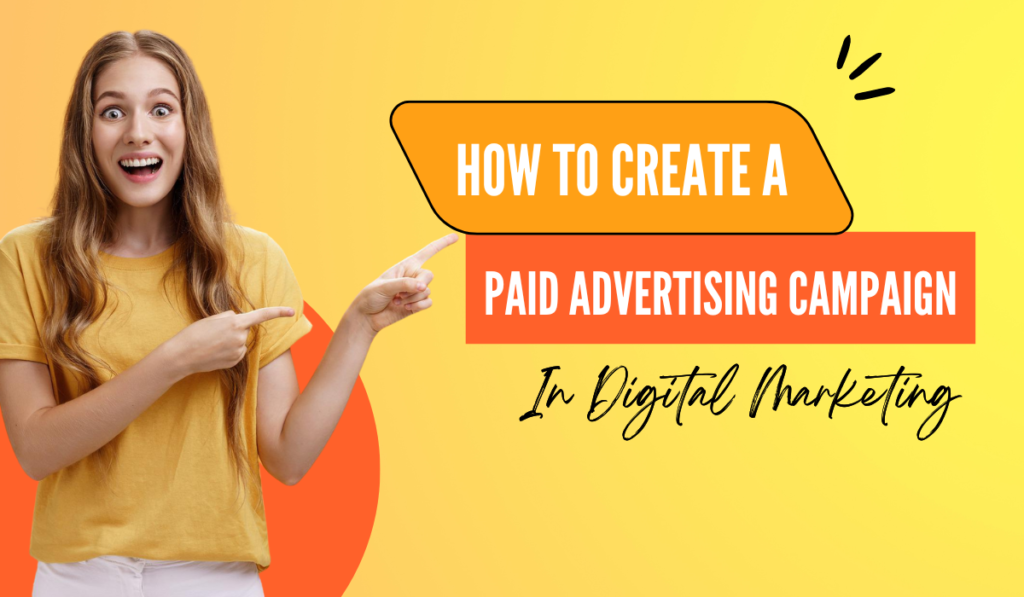What is paid advertising?
By the utilization of paid Advertising campaign in Digital Marketing, businesses can reach certain demographics by buying to display their commercials. The word “ad” is as old as the internet and, in principle, could be utilized to refer to any type of marketing, even billboard and print ads. However, when people use the term today, they’re most commonly referring to internet-based ads on search engines, social media platforms, and display networks.
A great deal of paid advertising platforms utilizes a bidding framework.. In simple terms, the advertiser decides how much cash they are willing to spend and how little they want to bid on every venture to accomplish what they want.
Per-click statistics are used to figure out the most popular bids. While you have the choice of bidding per view or conversion, pay-per-click, or PPC, advertising requires you to pay each time a user clicks on the link you provide. Your PPC bid and total ad budget determine where your ads show up on your target audience’s search results, social media feeds, or video streaming services and for how long. Special positions will go to the people having larger bids.
Also Read: The Complete Guide to Performing a Website Audit
How to create a paid advertising campaign in Digital Marketing
- Define your target audience
- Develop your creative
- Configure your tracking
- Launch and iterate
you’re spending ₹500 a day or ₹50,000, the process to create a paid advertising campaign follows the same four steps
Define your target audience
- The first step for each paid advertising campaign is identifying the intended audience. This can assist you figure out what platforms to use and what sort of targeting want to have in action. Ask yourself where your target customers spend their time online and what products they are interested in. This will inform what platforms to advertise on when planning your budget for your campaigns.
Develop your creative
- Your audience’s choices will impact the creative that you should create for a Paid Advertising Campaign in Digital Marketing. If you focus on search campaigns, you will need to write copy that communicates the benefits of your product. When you run internet or display ads, the goal is to create visually captivating material that draws users’ attention and delivers your USPs right away. Make sure your ad versions have enough variety for testing and efficiency, regardless of the audience you select.
Configure your tracking
- There are tools on each advertising platform for measuring the efficacy of supported campaigns. To have a clear image of success, it is important to put these up on your web page before launch.
- Digital advertising platforms each have their tracking mechanisms that you must integrate with your site. Platforms like Shopify have built-in integrations with major advertising platforms such as Meta, Google, and Pinterest, simplifying the setup by linking your accounts without requiring manual code insertion on your site. For other content management systems (CMS) or ad platforms, you may need assistance from a web developer.
- Each advertising platform offers a range of metrics to gauge your success. The key metrics for your paid advertising will vary based on your objectives and business model, but commonly tracked metrics include conversions, clicks, and impressions.
Launch
- You’re ready to go live once you’ve input the information about the demographics, and creativity. And budget for your target audience into your marketing platform. One of the benefits of paid ads is the wealth of data you receive; within a few days, your campaigns will provide a clear picture of which ads are effective and which aren’t. It’s best practice to monitor your ad campaigns at least once a week to identify opportunities for improvement.
How paid advertising can benefit your business?
- Relative to other kinds of digital marketing, paid advertising has several benefits, given the reality that it may be costly:
- Take hold of it. Businesses may right away reach thousands of people using paid advertising. Given that organic marketing cannot ensure reach, this reassured reach is beneficial. For context, the average cost to reach 1,000 people on Instagram in India is about ₹100 per thousand ad impressions.
- focusing. There are many different choices for targeting accessible in modern commercials. This includes behavioral targeting (e.g., serving ads to people who have already visited your site), interest targeting (e.g., serving travel ads to people who’ve shown an interest in traveling), Along with keyword targeting, and displaying ads to individuals who search on “top phones.”
- Quantifying the success of a Paid Advertising Campaign in Digital Marketing is crucial. To assist advertisers in learning about the return on investment, or ROI, of their advertising. Paid advertising systems have created complex measuring instruments. They use cookies, such as the Google Analytics tag, to track when users see an ad, click it, and then ultimately convert to making a purchase. They can specifically tie back to specific promotions, ads, or keywords, providing powerful insight into the success of paid advertising and into what creative and focus methods work best.
Categorizing paid advertising by the kind of location that appears in the commercials
- Search engine
- Social media
- Display
- Hybrid
Search engine
- A combination of paid search ads (chosen via an ad auction) and organic results (set up by the search engine’s proprietary algorithm) appear to users when they search on Google or Bing. Due to its capacity to target certain intentions, this form of advertising is quite effective. A searcher is probably inclined to buy if they type in “best smartphones under ₹20,000.”
Social media
- The user experience has non-ad material sprinkled within these commercials. Social media networks use audience data to deliver fitting advertisement to their users based on their actions on the platform, helping them understand their interests. For example, if you like a post on Instagram about cricket equipment, you are more likely to get served a cricket gear ad.
Display
- These commercials come in a variety of forms, including large-scale films and small, static boxes. Advertisers rarely resort to just one site for their display ad campaigns. Instead, a network of sites serves display ads. For example, if an advertiser were to use the Google Display Network to run a campaign targeting people interested in Bollywood movies, their ad could be shown on hundreds Several Bollywood-related websites that are available have been elected to show ads from Google’s partners.
Hybrid
- Search, social, and display ad categories are not well suited for hybrid advertising approaches. The most common examples are the Shopping advertisements on Google. These campaigns gather data about your product or service and turn it into responsive marketing that appears in search, and social networking sites, and show ad placements in a range of forms. They modify the commercial utilizing their algorithms to fit the environment where it is shown. For example, an ad for Ayurvedic skincare products might appear on search results, social media feeds, and display networks, with the format adjusting to fit each platform seamlessly.

